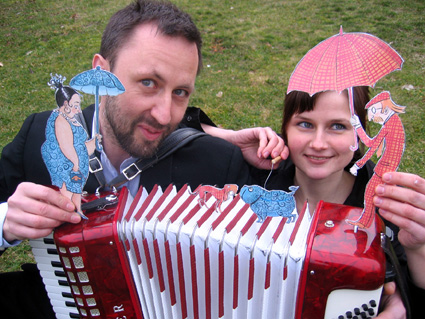by Guest Blogger Holly Hartman
 |
| Holly Hartman |
I’m a few minutes early for class, and instructor Jonathan
Little, the puppeteer and fabricator behind
Little’s Creatures, is chatting with students about puppetry. He tells us
where he buys the fur he uses in building his own monster puppets, why
medical-grade foam is a good choice for puppet hands, how he fixes a puppet’s
eyes and arms in place. I learn why all the Muppets are a bit cross-eyed and
what makes Kermit’s head especially difficult to construct.
This serendipitous conversation (among others) is one of the
pleasures of a class I’m taking at Puppet Showplace Theatre: “Furry Monsters
101,” an introduction to Muppet-style hand-and-rod puppets. One of the things
that impresses me about Puppet Showplace is how it supports puppetry not just as
a theater venue but also with workshops and courses like this, offering the
public a chance to work with seasoned teaching artists.
I’m a longtime fan of Puppet Showplace and a current volunteer,
but this is my first class. Seeing puppet shows here has gotten me curious
about what it would be like to try my own hand (literally) at puppetry. It’s an
art with many forms, but all, in my view, seem to involve some alchemy by which
a puppeteer brings an object to life. How does this happen?
Class One: Inhale, Exhale
In our first class, Jonathan tells us that one of the surest
ways to hook an audience is by letting them see your puppet breathe. He
demonstrates with a lifted hand: an inhale, wrist shifting upward; an exhale,
fingers subtly releasing the puppet’s breath. I am transfixed—it’s a creature!
But no—it’s a hand.
 |
| Jon Little hand makes all of the puppets for Furry Monsters 101 |
This suspension of disbelief is part of what fascinates me
about puppetry. Jonathan’s brother Chris, also a puppeteer, is helping out with
this class, and during our introductions he describes watching Puppet Showplace
artist emeritus Paul Vincent Davis animate a milk carton—it became “the
happiest milk carton in the world,” then the saddest. Puppetry, Chris says, involves
the ability to imbue objects with energy.
We make our hands into puppet mouth shapes and practice making
them breathe, sigh, sneeze, sniff, snore. Like infants, our hands then progress
from sounds to words. The technique involves one precise flap of the thumb per
syllable—downward, the way the human jaw moves in speech. We sing the alphabet,
slowly. My thumb sags in confusion when we reach the impossibly multisyllabic letter
W.
Finally, we try lip-synching to music. Time flies when your
puppet hands are having fun. Suddenly it’s 9:00 p.m., class is over, and around
the room students’ hands are rocking out to “Bohemian Rhapsody.”
Practice Makes Puppetry
For homework, I practice lip-synching with my hand. It’s
hard. It’s fun. The occasional moment of fluidity is a thrill. My puppet hand
has an affinity for the songs of Leonard Cohen—slow, simple lyrics punctuated
by danceable instrumentals and the odd long word. Hal-le-lu-jah.
Class Two: Hands in Puppets
In the second class, when we start using hand-and-rod
puppets, lip-synching feels different, strange. Each puppet is a new
experience. I feel awkward maneuvering the tiny mouth of the first one I try,
and enjoy posing the jointed neck of the second. Each student performs a scripted
monologue, and when my turn comes I keep flapping my hand upward, causing what
Jonathan calls, during the critique, “a bit of flip-top head.” Whoops.
Like everything else we’ve done in this very immersive
class, the critique is fun and illuminating. I like seeing what qualities each
person brings to their puppet performance. Some puppet characters are kinetic,
others droll. Talking about what we saw that worked—and what didn’t—is
invaluable.
Lights, Camera…
Next, we take our first steps—or, rather, make our puppets
take their first steps—in front of the camera and video monitor. It’s harder
than I would’ve guessed, both because it’s tricky to keep your puppet moseying
along on its fictional floor level without slumping, and because on a video
monitor, left and right are reversed. When you stroll your puppet onscreen from
stage right, its furry face appears on the monitor at stage left. Surprise!
Also surprising: I love working with the monitor. It’s magic
to see the puppet isolated in the world of the television screen, moving within
its own reality, the puppeteer nowhere seen. I think I could watch that furry
monster explore its onscreen world for hours, or at least until my arm went
numb from holding it overhead. I feel like the kid who does not want to stop
playing with a new toy.
As I leave the theatre, I am a little stunned at how much
I’ve gotten to try in the last two hours. For someone who grew up with Sesame Street, it’s a heady feeling. And
we have two more classes to go… I’ll be back in a couple weeks with a final report!










































































